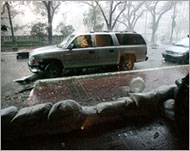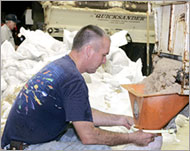New Orleans braces for Katrina
Gusty winds and heavy rain are sweeping across southern Louisiana as giant Hurricane Katrina bears down on the US Gulf coast, threatening to swamp New Orleans.

At least a million people had fled the area ahead of the powerful storm, which weakened as it neared land to top winds of 250kph and was downgraded to a Category 4 storm on the five-step Saffir-Simpson scale early on Monday.
As of 0700 GMT, the centre of the storm was 208km south-southeast of New Orleans, the National Hurricane Centre in Miami reported.
It said gusts as high as 120kph had been recorded at Grand Isle on the Louisiana coast. In New Orleans, gusts had reached 96kph.
Weather experts issued dire predictions for the fate of New Orleans, saying that thousands of homes could be damaged or destroyed and a million people left homeless by a storm surge forecast to be as high as 8.5 metres above normal.
Even into Monday morning, Louisiana highways were thick with traffic as evacuees sought safety as far away as Texas, 425km to the west.
Elderly victims
 |
|
The mayor of New Orleans |
In Baton Rouge, officials said three people from a New Orleans nursing home had died during their evacuation to a Baton Rouge church.
They said they were among nearly two dozen people from the home who were on a bus stuck in traffic for hours during the 125km trip.
The mayor ordered on Sunday an immediate evacuation for all of New Orleans, a city below sea level with 485,000 inhabitants.
Acknowledging that large numbers of people, many of them stranded tourists, would be unable to leave before the eye of the storm strikes land some time on Monday morning, the city set up 10 places of last resort, including the Superdome arena.
“This is a once-in-a-lifetime event,” Mayor Ray Nagin said. “The city of New Orleans has never seen a hurricane of this magnitude hit it directly.”
The mayor said a direct hit by Katrina’s storm surge would probably top the levees that protect the city from the surrounding water of Lake Pontchartrain, the Mississippi River and marshes.
The bowl-shaped city must pump water out during normal times, and the hurricane threatens electricity that runs the pumps.
“We are facing a storm that most of us have long feared,” Nagin said.
President George Bush pledged federal support.
Highways packed
Rain started falling on extreme southeastern Louisiana by midday on Sunday as the storm moved across the Gulf of Mexico towards land.
Highways in Mississippi and Louisiana were jammed as people headed away from Katrina’s expected landfall. All lanes were limited to northbound traffic on two major interstate highways.
 |
|
Marc Crawford bags sand late into |
The mayor said people who opted to go to the Superdome should take enough food and supplies to last three to five days.
He said that police and firefighters would fan out throughout the city telling residents to get out, and that police would have the authority to commandeer any vehicle or building that could be used for evacuation or shelter.
Tina and Bryan Steven of Forest Lake, Minnesota, sat dispirited on a pavement on Sunday morning outside their hotel in the French Quarter.
“We’re choosing the best of two evils,” Bryan Steven said. “It’s either be stuck in the hotel or stuck on the road.”
Bracing for worst
 |
|
At least a million people have |
Storm surges of up to 8.4 metres topped by waves of up to 9 metres are possible in some areas, hurricane centre meteorologist Chris Sisko said.
As much as 38cm of rain is possible.
Only three Category 5 hurricanes – the highest on the Saffir-Simpson scale – have hit the US since record-keeping began.
The last was 1992’s Hurricane Andrew, which levelled parts of South Florida, killed 43 people and caused $31 billion in damage.
The others were the 1935 Labour Day hurricane that hit the Florida Keys and killed 600 people, and Hurricane Camille, which devastated the Mississippi coast in 1969, killing 256.
Katrina’s landfall could still come in Mississippi and affect Alabama and Florida, but it looked likely to come ashore on Monday morning on the southeastern Louisiana coast, said Ed Rappaport, deputy director of the hurricane centre in Miami.
That put New Orleans squarely in the crosshairs.
Mandatory evacuations were ordered all along the Mississippi coast, where casinos were closed on Sunday.
National Guard units had already been deployed, state officials said.
Katrina has been blamed for nine deaths in South Florida.
It was the sixth hurricane to hit Florida in just over a year.